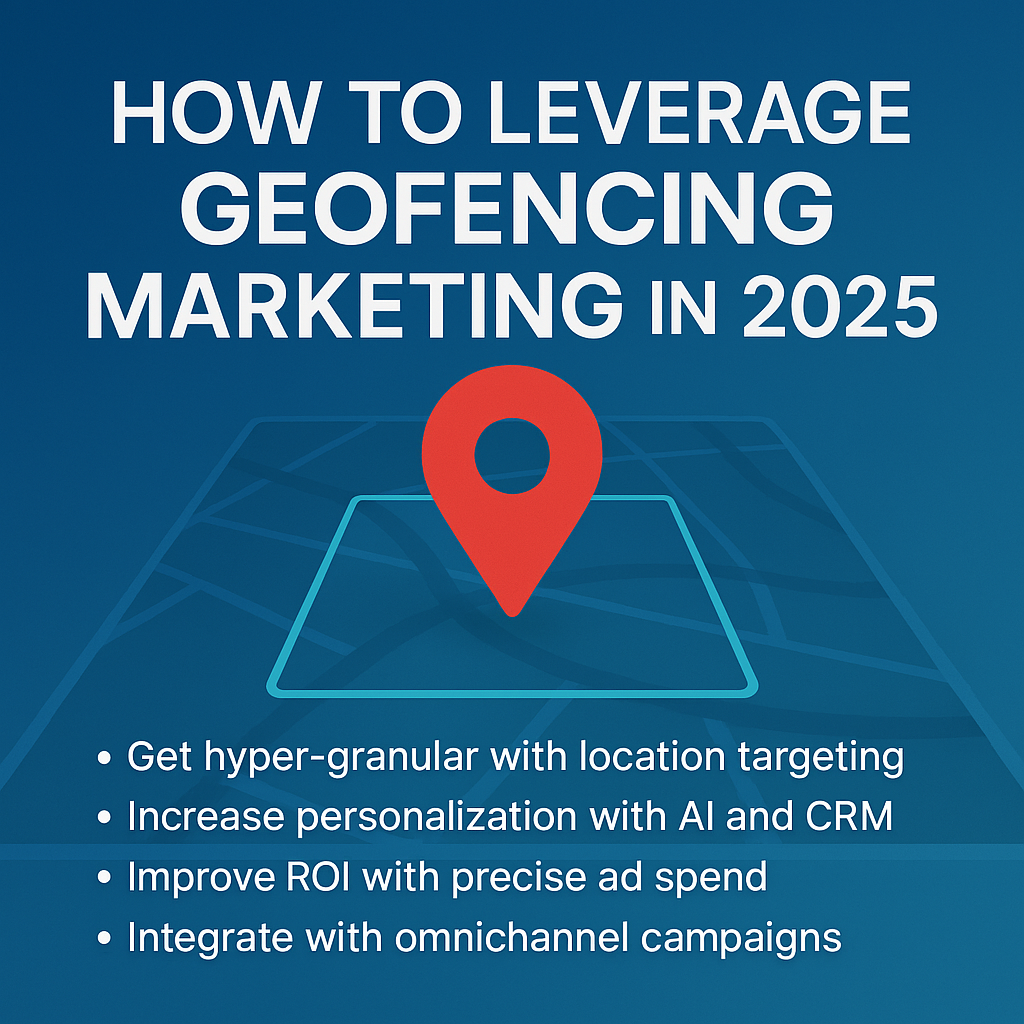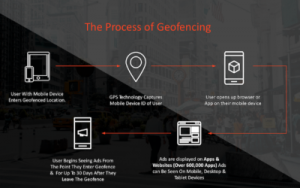Geofencing marketing isn’t new, but in 2025, it’s evolved into a sophisticated, real-time targeting tool that savvy marketers can’t afford to ignore. With advancements in GPS accuracy, 5G connectivity, and AI-driven analytics, geofencing has become an essential part of digital strategy. When done right, it allows businesses to reach consumers based on their exact location and intent, delivering timely, relevant messaging that drives measurable results.
What Is Geofencing Marketing (And Why It’s Evolving)
>>>>>>>>>>>>>>>>>>>>Geofencing marketing is a location-based advertising strategy that uses GPS, Wi-Fi, RFID, or cellular data to create a virtual boundary—or “geofence”—around a specific geographic area. When a user’s mobile device enters or exits that area, it can trigger various marketing actions such as push notifications, display ads, or app-based alerts. This allows businesses to connect with potential customers at the exact moment they’re near a physical location, whether it’s a retail store, event venue, or even a competitor’s site. It’s a strategic way to deliver hyper-relevant messaging when and where users are most likely to engage or convert.
In 2025, geofencing has become far more sophisticated. It’s no longer just about drawing a radius around a location; it’s about using AI, real-time behavioral data, and CRM integration to predict intent and personalize experiences. Businesses now layer location data with customer profiles, purchase history, time-of-day signals, and even weather patterns to create ultra-targeted campaigns. The result? Smarter, more effective marketing that anticipates needs, improves user experience, and drives measurable results both online and offline. As technology and consumer expectations continue to evolve, geofencing has transformed from a proximity tool into a core pillar of performance-driven digital strategy.
The Key Benefits of Geofencing in 2025
Hyper-localized Engagement: Geofencing marketing allows brands to connect with consumers based on their exact geographic location. Whether they are near a storefront, inside a competitor’s location, or attending a live event, businesses can deliver highly relevant messages at the perfect moment. This hyper-local targeting improves engagement by reaching users when they are most likely to take action.
Increased Personalization: Thanks to AI and CRM integration, marketers can now go beyond location alone. Campaigns can be personalized using behavioral data such as browsing history, past purchases, and demographic information. This level of personalization increases the effectiveness of messaging, resulting in higher click-through and conversion rates.
Improved ROI: Geofencing marketing reduces wasted ad spend by targeting only users within relevant physical zones. With more precise targeting, brands can ensure their advertising dollars are spent efficiently, leading to increased return on investment (ROI) and better overall campaign performance.</p></p></p></p></p></p>
<strong>Better Attribution: One of the strongest benefits of modern geofencing is its ability to track foot traffic and tie it back to spe
cifi
c di
gita
l ca
mpai
gns. With tools that monitor location-based user behavior, marketers can attribute store visits and in-person actions directly to online ads, providing valuable insights into what’s working.
Omnichannel Integration: In 2025, geofencing integrates seamlessly across channels. Brands can trigger location-based messaging via display ads, social media, SMS, email, and mobile apps, creating a consistent and cohesive customer experience. This unified approach enhances campaign reach and strengthens brand impact across multiple touchpoints.
Must-Have Tech Stack & Tools
To unlock the full potential of geofencing marketing in 2025, it’s no longer enough to rely on a single tool or channel. The real power lies in stacking the right technologies—each playing a unique role in precision targeting, real-time engagement, and data-driven optimization. By integrating demand-side platforms (DSPs), AI-driven segmentation, CRM systems, and mobile SDKs, marketers can create seamless, location-aware experiences that not only reach users at the right place and time but also speak directly to their intent and behavior. This layered tech approach allows businesses to personalize messaging, automate responses, and measure results with pinpoint accuracy—making every marketing dollar work harder. The more intelligently your tools work together, the more competitive and agile your geofencing strategy becomes.
Here’s a breakdown of the essential tools you should include in your 2025 geofencing tech stack:
Advanced Demand-Side Platforms (DSPs)
Platforms like Simpli.fi and GroundTruth specialize in hyper-local advertising, allowing marketers to create and manage geofencing campaigns with precision. These DSPs offer real-time bidding, audience segmentation, and robust reporting tools tailored to location-based marketing.
AI-Powered Segmentation Tools
Tools like Reveal Mobile and Foursquare Attribution combine geolocation with behavioral and demographic data, enabling smarter audience targeting. These platforms help marketers reach high-intent users with personalized messaging based on real-world movement and digital behavior.
CRM Integrations
Connecting geofencing data with platforms like Salesforce Marketing Cloud or HubSpot enables marketers to tailor messaging, automate follow-ups, and track customer journeys across channels. This integration ensures consistent, personalized communication before, during, and after location-based interactions.
Mobile App SDKs
Incorporating SDKs like OneSignal or Airship into your mobile app allows for rich push notifications and in-app messaging triggered by user location. These tools enhance the customer experience by delivering relevant offers and updates in real time.
Use Cases by Industry
Retail & CPG
Geofencing marketing is a powerful tool for retailers and consumer packaged goods (CPG) brands. By targeting shoppers near a competitor’s store, inside a shopping mall, or close to your own storefront, you can serve timely mobile ads or push notifications with limited-time offers. This strategy boosts foot traffic, increases brand visibility, and drives impulse purchases at the point of decision.
Real Estate
Real estate professionals can use geofencing to engage potential homebuyers visiting open houses or high-demand neighborhoods. By serving hyper-local ads that promote available listings, virtual tours, or appointment scheduling, agents can connect with serious buyers in real time—maximizing lead quality and conversion rates.
Restaurants & Hospitality
For restaurants, cafes, and hotels, geofencing offers the ability to target users nearby with time-sensitive promotions. Think happy hour deals, lunch specials, or exclusive offers during events. This location-based advertising tactic increases local traffic, enhances customer loyalty, and helps fill seats during slower periods.
Healthcare
Urgent care centers, dental offices, and clinics can benefit from geofencing by targeting users near their locations with appointment availability or walk-in service messaging. With location-based marketing, healthcare providers can increase patient volume, promote new services, and improve local brand awareness at critical decision-making moments.
Event Marketing
Geofencing is a must-have for event marketing in 2025. Marketers can engage attendees in real time with promotions, event details, or exclusive content during concerts, trade shows, or festivals. After the event, users can be retargeted with follow-up offers, surveys, or branded content, extending the customer journey beyond the venue.
Metrics That Matter
- Store Visit Lift: Tracks the impact of your ads on physical visits.
- Conversion Rate: Measures how many users took action after seeing the ad.
- Cost Per Visit (CPV): Helps assess campaign efficiency.
- Foot Traffic Attribution: Links digital impressions to in-store behavior.
- Dwell Time: Indicates how long users stayed in the geofenced area.
- ROAS: Gauges return on your ad spend.
Common Pitfalls to Avoid
Targeting Too Broadly or Too Narrowly
One of the most common mistakes in geofencing marketing is setting your radius incorrectly. A geofence that’s too broad can lead to wasted ad spend and irrelevant impressions, while one that’s too narrow might limit your reach and miss potential customers. Defining zones based on customer behavior, location type, and campaign goals is essential.
Using Geofencing in Isolation Without Other Data Layers
Relying solely on location data limits the potential of your campaigns. Geofencing should be paired with audience insights, behavioral data, and CRM information to deliver truly relevant messaging. The more context you have, the more effective your targeting will be.
Failing to Personalize Creative and Messaging
Serving the same generic ad to every user within a geofence undermines the power of location-based marketing. Use dynamic creative that speaks to users’ current environment, time of day, or potential needs. Personalization drives higher engagement and stronger conversions.
Overlooking Privacy and Opt-In Standards
With evolving data privacy laws like GDPR and CPRA, it’s critical to ensure users have opted in to location tracking and that your campaign complies with regulations. Ignoring this not only risks legal trouble—it erodes trust with your audience.
Ignoring Post-Campaign Analytics and Optimization
Too often, brands launch geofencing campaigns and forget to analyze performance. Measuring foot traffic, dwell time, and conversion lift helps refine future strategies. Continuous optimization is key to scaling success and improving ROI over time.
Final Thoughts
Every footstep, every check-in, every neighborhood visit tells a story — geofencing gives you the power to respond in real time. In 2025, this technology goes beyond reaching people near your business. It focuses on understanding movement and intent. Timing is considered with a level of precision we’ve never seen before. When combined with smart creative and behavioral insights, geofencing transforms into more than just a marketing tool. It becomes a revenue-driving engine.
 If you’re ready to stop guessing, it’s time to create ads that truly convert. Rethink your strategy for location-based marketing. Our team of geofencing experts can help you build and launch effective campaigns. We also optimize them to ensure success. Whether you’re targeting foot traffic or high-intent mobile users, we can assist you. We help you reach local communities effectively. With our support, you can reach the right audience at the right moment every time.
If you’re ready to stop guessing, it’s time to create ads that truly convert. Rethink your strategy for location-based marketing. Our team of geofencing experts can help you build and launch effective campaigns. We also optimize them to ensure success. Whether you’re targeting foot traffic or high-intent mobile users, we can assist you. We help you reach local communities effectively. With our support, you can reach the right audience at the right moment every time.
👉 Ready to take your geofencing campaigns to the next level? Book a strategy session with our team today and see how we can help you drive results that move the needle.


